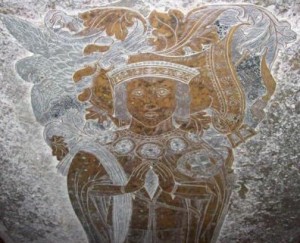
Today, I’m going to look at Sir Thomas Boleyn, Earl of Wiltshire, Earl of Ormonde and Viscount Rochford, the father of Queen Anne Boleyn and an important man at the court of King Henry VIII.
Popular culture (“The Tudors”, “The Other Boleyn Girl” etc.) paints him as a cunning and manipulative man who will stop at nothing to curry favour and raise his status at court, and many Anne Boleyn fans dislike him, feeling that he let Anne and George down in their hour of need and just carried on with his life and career, but was Thomas Boleyn really like that? Let’s examine his background, career and the different views people have of him and see if we can discover the real Thomas Boleyn.
Background
Thomas Boleyn was born in around 1477, the eldest of ten children. His parents were Sir William Boleyn (1451 – 1505), son of Geoffrey Boleyn (1406 – 1463) the Lord Mayor of London, and Lady Margaret Butler (1454 – 1539), daughter of Thomas Butler, the 7th Earl of Ormonde (1426 – 1515). Thomas’s mother, Margaret was a descendant of Eleanor de Bohun (1304 – 1363) and her first husband James Butler, 1st Earl of Ormonde, and interestingly Eleanor de Bohun was the granddaughter of Edward I and his first wife, Eleanor of Castile.
I made the point in my post Anne Boleyn’s Royal Blood, based on research done by Olivia Peyton and Robert Milne from the Facebook group Anne Boleyn1, that Eleanor of Castile was descended from Henry II and Eleanor of Aquitaine, so Thomas Boleyn wasn’t the commoner some people have made him out to be.
Thomas’s father, Sir William Boleyn, was High Sheriff of Kent and his paternal grandfather, Geoffrey Boleyn (1406 – 1463) was a successful mercer (a merchant of fine cloth) and also served as Lord Mayor of London in 1458. It was Geoffrey Boleyn who purchased Hever Castle in 1462 – it had previously belonged to William Fiennes, 2nd Baron Saye and Sele – and set about renovating it and rebuilding it into the manor house that stands today.
Marriage and Issue
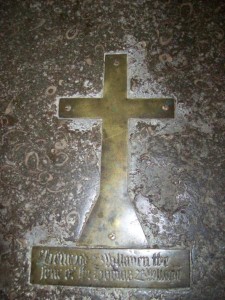
Thomas Boleyn married Lady Elizabeth Howard, daughter of Thomas Howard, the Earl of Surrey (and later the 2nd Duke of Norfolk) in around 1498/1499. We do not know the precise date of their marriage but Eric Ives2 points out that Elizabeth’s jointure was settled on her in the summer of 1501, suggesting a relatively recent marriage.
As far as issue is concerned, we know that the Boleyns had at least five children – Mary, George, Anne, Thomas and Henry – because we have records of them. Many people have not heard of Thomas and Henry but that is because they did not survive childhood. Thomas is buried at Penshurst Church and Henry is buried at St Peter’s Church, Hever. This photo shows the stone marker of Henry’s grave on the floor of St Peter’s, near his father’s tomb. In a letter written to Thomas Cromwell in July 1536, Thomas Boleyn recalled the financial hardship of his early years of marriage, mentioning that his wife “brought me every year a child”3 but we do not know, conclusively, the birthdates of the Boleyn children and can only hypothesise.
Eric Ives believes that Mary was the eldest and was born around 1499, then Anne in 1500/1501 and then George in about 1504, but what about Thomas and Henry? Well, I discussed this with Alison Weir and she pointed out that it is likely that they were born before George because of their names – Thomas after his father and Henry to honour the King, Henry VII – and that they must have still been alive when George was born, otherwise George would have been named Thomas or Henry. If we believe that Anne was born in 1501 then Thomas and Henry could have been born in 1502 and 1503, if Elizabeth did indeed bring her husband a child every year, or perhaps one of them was born before Mary. Obviously, this all changes if you believe that Anne Boleyn was born in 1507!
Career and Offices
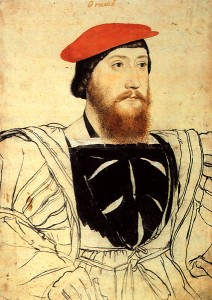
Although Paul Friedmann4 writes of how it was Thomas’s father-in-law, the Earl of Surrey, who helped to advance Thomas’s interests at court, we also have to take into account that Thomas Boleyn was an incredibly intelligent man and an asset that any king would want at court. Eric Ives writes that Thomas “was a man of some education, far and away the best speaker of French in the Tudor court, with Latin as well, and cultured enough to commission several items from Erasmus”5 and in his notes on his chapter “A Courtier’s Daughter”, Ives writes that it is probable that Thomas also had legal training. Legal training, a flair at languages and a cultural disposition, no wonder he was chosen by Henry VIII to undertake many embassies and diplomatic missions.
Thomas Boleyn also knew the importance of being involved in courtly entertainment, jousting and tournaments, and there are records of him fighting with the King at Greenwich in May 1510 and being an “answerer” in February 1511 at the Westminster challenge6.
Thomas Boleyn Here are the highlights of his career, including the rewards he was given for his loyalty and hard work:-
- Mentioned in the Pardon Roll at the beginning of Henry VIII’s reign – “20 June. Thomas Boleyn, Bullen or Bulleyn, of Bishops Lynn and Boston, gent., innholder or yeoman, late yeoman of the Crown of Henry VII.”7
- 1509 – Knighted
- 1517 – Chosen to look after Margaret, Henry VIII’s sister, on her visit to England8.
- 1511 – Made joint governor of Norwich Castle with Sir Henry Wyatt9
- 1511 and 1517 – Appointed High Sheriff of Kent
- 1512 – Sent as ambassador to the Low Countries
- 1519-1523 – Appointed as Ambassador to the court of France, attended the Field of Cloth of Gold, attended the meeting at Gravelines with Emperor Charles V, participated in the Calais Conference of 1521 and was then appointed as ambassador to Spain.10
- 1522 – Obtained the patent of the treasurer of the household, the stewardship of Tunbridge, the receivership of Bransted, and the keepership of the manor of Penshurst.11
- 1523 – Granted the keepership of Thunderley and Westwood Park.12
- 1523 – Made Knight of the Garter
- 1524 – Granted the stewardship of Swaffham.13
- 1525 – Made Lord Rochford
- 1527 – Diplomatic missions to France
- 1529 – Sent as envoy to seek support for the divorce of Henry VIII and Catherine of Aragon from Emperor Charles V and Pope Clement VII.
- 1529 – Thomas given the Earldom of Ormonde after the Butlers surrendered the title in return for the disputed Ormonde lands on a long lease.
- 1529 – Made Earl of Wiltshire.14
- 1530 – Appointed Lord Privy Seal after the fall of Cardinal Wolsey.15
- March 1536 – The Boleyn managed to secure letters patent reconstructing Thomas Boleyn’s lease of the Crown honour of Rayleigh in Essex. Sir Anthony Browne was forced to surrender this office.16
As you can see from this long list of jobs and rewards, Thomas Boleyn was one of the King’s main men from the beginning of his reign in 1509 until the fall of the Boleyn faction in 1536. He was an active and important member of the Privy Council and Eric Ives writes of how the King spoke of Thomas Boleyn as being a skilled negotiator and how it is evident that he knew how to handle the king17. He certainly reaped his rewards.
Character
As I said earlier, fiction, movies and TV series have portrayed Thomas Boleyn as a man who used and manipulated his daughters to advance his career. Even historians judge him harshly – Eric Ives quotes Friedmann as saying that Thomas Boleyn was “mean and grasping”18 and P W Sergeant as saying “it is clearly hopeless to attempt a defence of Sir Thomas”19. Now, we know that Mary Boleyn was Henry VIII’s mistress and obviously Anne was in a relationship with the King for around 10 years, but did Thomas purposely put his daughters in the King’s path? Was he a pimp who prostituted his daughters for his own gain? It is hard to know, but we need to take into account Tudor beliefs regarding women and the context the Boleyns were living in. Women were seen as second class citizens, as chattels, and a daughter’s only use to a father was to marry well so that she was supported financially and so that she could bring honour and favour to her family. I don’t think that Thomas was unusual in using his daughters to gain favour and having a daughter become mistress to the King brought all sort of rewards and prestige to the family and did not seem to affect the woman’s long term reputation or marriage prospects. I think that Thomas was simply an ambitious courtier and an opportunist.
Joanna Denny is one historian who does not see Thomas as a scheming manipulator at all and writes of how he recalled Mary to England when he heard of her exploits at the French Court and removed Anne from court, when he spotted the King’s interest in her, because “while he could do nothing to prevent the King’s affair with Mary, he could try to protect his younger daughter.”20
I guess we’ll just never know what kind of man Thomas really was but he cared enough about his daughters to make sure that they received a top notch education, instead of simply learning needlework and homemaking skills. He also sent them abroad and Anne Boleyn was famed for her fluency in French, her musical skills and intelligence. It is said that Mary Boleyn had the Howard classical beauty whereas it seems that Anne’s dark looks came from the Boleyn/Butler side of the family and I also think that Anne was her father’s daughter, having his ambition and intelligence.
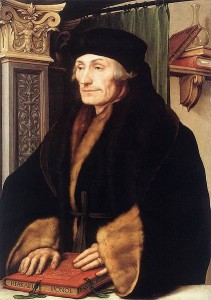
Thomas Boleyn the Reformer
While we can argue until we’re blue in the face over Anne Boleyn’s faith and her role in the English Reformation, it is clear that her father played a role in advancing reform by using his diplomatic missions to smuggle literature into England, literature which would have been viewed as heretical. Joanna Denny writes:-
“Thomas Boleyn was a firm advocate of the “New Religion”. He imported dangerous tracts that could have led to his condemnation as a heretic, one of which he translated and dedicated to his daughter Anne. He commissioned works from Erasmus, who wrote a commentary for him on Psalm 23 and called him “egregie eruditus“, outstandingly learned.”21
Denny goes on to describe him as “a man of principle, learned and daring in taking risks for his beliefs. He was a supporter of the New Religion, a Protestant, although this term was not in use until 1529”22
and writes of how he kept in contact with French reformers.23 Ives too writes of how Thomas Tebold travelled around Europe in 1535 and 1536, supported by Thomas Boleyn, spreading the news that Thomas was a patron of the New Learning and New Religion24. It is clear that Anne and George’s interest in humanism and reform stemmed from their father.
Thomas Boleyn and the Fall of Anne Boleyn
On the 24th April 1536, two commissions of oyer and terminer were set up to investigate treason and Thomas Boleyn was one of the commissioners. Little did he know that he would be sitting in judgement on four of the men accused of committing adultery with his daughter, Anne Boleyn. The setting up of this commission was the beginning of the end for the Boleyn faction and May 1536 saw the downfall and executions of two of Thomas Boleyn’s children, Anne Boleyn and George Boleyn, and key Boleyn supporters. So, how did Thomas Boleyn escape? Friedmann explains:-
“Anne’s friends were closely watched, but it was not thought necessary to interfere with the liberty of Lord Wiltshire. He was a mean egotist and coward, and from motives of prudence had always disapproved of his daughter’s bold and violent courses. There was, therefore, no reason to fear that he would try to defend her.”25
Harsh words! It could be argued that Thomas Boleyn escaped because he could not be implicated in his daughter’s affairs, who knows, but he was a lucky man. He is often criticised for not fighting for Anne and George, after all, Weston’s family did all that they could to try and get Weston released, yet there is no record of Thomas Boleyn lifting a finger to help his children. But who can judge Thomas Boleyn? He knew the King and Cromwell well enough to know that there was no hope and who can blame him for blending into the background and thinking of his own survival when he realised that there was nothing he could do? We can only imagine the heartache he felt on the brutal deaths of his children, the guilt that he felt, and it is likely that the events of 1536 led to some kind of breakdown in Thomas’s marriage to Elizabeth, suggested by the fact that she was buried at Lambeth, in the Howard church, rather than at Hever.
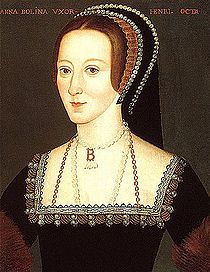 Life After Anne
Life After Anne
Although Thomas Boleyn fell from favour after the fall and execution of his daughter, he was a survivor and did not give up. He was active in squashing the rebellion of the Pilgrimage of Grace in 1536, he was present at Edward VI’s christening in 1537, and Ives talks of how he buttered up Cromwell by lending him his chain and Garter badge26. By 1538, Thomas Boleyn was back properly at court and it was even rumoured that he would marry Margaret Douglas, Henry VIII’s niece27! However, he did not live long after Anne’s fall, dying in March 1539, around a year after his wife. The fact that Henry VIII ordered masses to be said for Thomas’s soul is clear evidence that Thomas was back in favour by then.28
Thomas Boleyn’s Resting place
Thomas Boleyn is buried in a tomb at St Peter’s Church, Hever, Kent, just near his former home, Hever Castle. His tomb is decorated by a magnificent brass which shows him dressed as a Knight of the Garter. Above his right shoulder is his daughter Anne’s falcon crest and at his feet there is a griffin. His son, Henry Boleyn, lies nearby.
Final Thoughts
Thomas Boleyn can be described as ambitious and self-seeking, but I do not think he was an evil man who manipulated his children and then turned his back on them in their hour of need. In my opinion, he was simply a product of Henry’s court and his time, a courtier who enjoyed basking in royal favour but who knew the sense of hiding when things got too hot. He was a survivor. I am sure that Anne would have understood the way he handled things in May 1536 and would have forgiven his shortcomings, she knew how things at court worked.
Notes and Sources
- The Anne Boleyn Facebook Group run by Olivia Peyton and Robert Mylne
- The Life and Death of Anne Boleyn, Eric Ives, p17
- L&P, xi.17, Letter from Thomas, Earl of Wiltshire to Thomas Cromwell, dated Hever, first Sunday of July.
- Anne Boleyn, P Friedmann, p25
- Ives, p10
- Ives, p10
- Pardon Roll of 1509 L&P i.438
- L&P ii.1475
- Friedmann, p25
- Ives, p10
- Friedmann, p26-27
- Ibid.
- Ibid.
- Ives, p36
- Friedmann, p51
- Ibid., p306
- Ives, p11
- Ibid., p6
- Ibid.
- Anne Boleyn, Joanna Denny, p49
- Ibid., p11
- Ibid., p38
- Ibid., p100
- Ives, p263-4
- Friedmann, p232-33
- Ives, p353
- Ibid.
- LP xiv. 950